Exploring Smilax Rotundifolia: Nature’s Hidden Gem
Table of Contents
Introduction:
Smilax rotundifolia is a plant that many people might not know about, but it has unique qualities that make it stand out. Commonly known as the round-leaf greenbrier, this plant is part of the Smilacaceae family. It grows in many parts of the world, including woodlands and forests, where it’s often spotted climbing on trees or spreading along the ground. Smilax rotundifolia is easily recognized by its round, shiny leaves and its thorny vines that allow it to climb high into the trees.
This plant is not only attractive but has also been used for centuries in traditional medicine. People have found various ways to use Smilax rotundifolia to help with health issues, from treating joint pain to improving respiratory health. The roots, leaves, and stems of the plant are believed to have healing properties, making it an important part of many folk medicine practices.
In this blog post, we’ll explore Smilax rotundifolia in more detail. From its physical features and growth habits to its many medicinal uses, there’s so much to learn about this fascinating plant. Whether you’re interested in gardening, herbal medicine, or simply curious about the plant life around you, Smilax rotundifolia is worth knowing more about.

What is Smilax Rotundifolia? A Quick Introduction
Smilax rotundifolia is a plant commonly known as round-leaf greenbrier. It belongs to the Smilacaceae family and is found in many parts of the world. This plant is known for its ability to climb trees and shrubs, spreading across various areas. Its round, glossy leaves and thick, thorny vines make it stand out in nature. You can spot this plant in forests, woodlands, and even along roadsides, where it often thrives in both sunny and shaded areas.
The plant’s climbing vines are one of its most noticeable features. Smilax rotundifolia uses its thorn-covered vines to attach to nearby trees, fences, or other plants, allowing it to grow tall and spread wide. This climbing ability helps it to reach more sunlight, which is important for its survival. The vines are often thick and covered in small, sharp thorns, which protect the plant from animals trying to eat it.
Another key feature of Smilax rotundifolia is its leaves. The leaves are rounded, shiny, and dark green, which helps them capture sunlight more effectively. These leaves are quite unique compared to other plants in the area and give the plant a distinctive look. The plant’s leaves can grow up to 3 inches in diameter, making them easy to spot if you’re out hiking or walking through the woods.
In the spring and summer, Smilax rotundifolia produces small, greenish flowers that are often hidden among the leaves. While these flowers are not very showy, they play a key role in the plant’s reproduction. After the flowers bloom, the plant produces small berries that turn dark purple or black when ripe. These berries attract birds, which help spread the seeds, allowing the plant to grow in new areas.
Overall, Smilax rotundifolia is an interesting and adaptable plant. It can grow in a wide range of environments, from forests to roadsides, and its climbing nature allows it to thrive in places where other plants might not. Whether you’re interested in botany or just curious about the plants around you, learning about Smilax rotundifolia can give you a new appreciation for the natural world.
The Amazing Features of Smilax Rotundifolia
Smilax rotundifolia is a plant with many interesting features that make it stand out in nature. One of its most amazing qualities is its ability to climb. The plant has long, thick vines that are covered in sharp thorns. These thorns help the plant attach itself to nearby trees, shrubs, or even fences. As it climbs, Smilax rotundifolia can grow tall and wide, reaching for the sunlight it needs to survive. This climbing ability makes it a true survivor in forests and woodlands where it competes for light.
Another standout feature of Smilax rotundifolia is its round, glossy leaves. The leaves are deep green and smooth, with a shiny surface that reflects light. This helps the plant capture more sunlight, which is essential for photosynthesis. The round shape of the leaves makes them easy to recognize and adds to the plant’s distinctive appearance. These leaves not only look beautiful but also serve an important role in the plant’s growth and survival.
In the spring and summer, Smilax rotundifolia blooms small, greenish flowers that are tucked away among the leaves. While these flowers may not be as bright or showy as those of other plants, they are an important part of the plant’s life cycle. The flowers eventually turn into small berries, which ripen to a dark purple or black color. These berries attract birds, who feed on them and help spread the plant’s seeds to new areas. This helps Smilax rotundifolia grow in more places, ensuring its survival.
The plant’s ability to grow in different environments is another amazing feature. Smilax rotundifolia can be found in a wide range of habitats, from shaded forest floors to sunny roadside areas. Its ability to thrive in both sunny and shady locations makes it an adaptable plant. Whether it’s climbing trees in the forest or creeping along the ground, Smilax rotundifolia can grow in many different places, making it a versatile and hardy species.
Finally, Smilax rotundifolia has medicinal properties that add to its appeal. For centuries, this plant has been used in traditional medicine to treat various ailments. Its roots and leaves are believed to have healing powers, with uses ranging from reducing joint pain to improving respiratory health. This combination of beauty, versatility, and health benefits makes Smilax rotundifolia a truly remarkable plant.
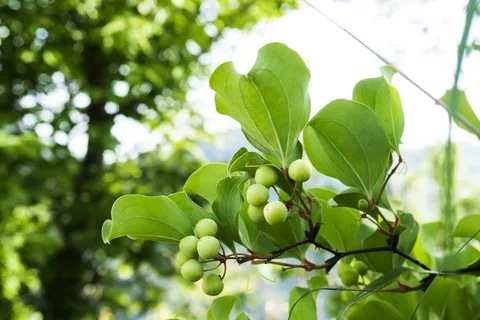
Where Does Smilax Rotundifolia Grow? A Look at Its Habitat
Smilax rotundifolia is a plant that thrives in a variety of habitats, which is one of the reasons it’s so adaptable. You can often find it growing in forests, particularly in areas that have both shaded and sunny spots. It enjoys the protection of trees, where it can climb up and spread out, reaching for the light. These areas provide the perfect conditions for the plant, as it needs both the shelter of the forest and access to sunlight for healthy growth.
Another common habitat for Smilax rotundifolia is along roadsides and trails. The plant is able to grow in places that may be disturbed by human activity, like the edges of wooded areas or areas cleared for paths. It’s quite resilient and can adapt to both disturbed and undisturbed environments. The combination of open spaces and the ability to climb surrounding plants gives Smilax rotundifolia a chance to grow quickly and spread its vines across large areas.
You might also spot Smilax rotundifolia in wetlands, where it can grow near streams or marshy areas. The plant does well in damp soils, which provide the necessary moisture it needs to thrive. In these wet habitats, Smilax rotundifolia may grow near the water’s edge, climbing up trees or shrubs that grow near the water. This ability to grow in various types of soil—whether it’s dry, moist, or wet—makes Smilax rotundifolia a very versatile plant.
The plant is also found in temperate regions, where the climate is neither too hot nor too cold. Smilax rotundifolia can survive in areas that experience seasonal changes, growing in both warm and cool months. Its ability to adjust to changing temperatures makes it a strong competitor in nature, allowing it to thrive in different conditions. Whether it’s a warm, sunny day or a cooler, shady afternoon, Smilax rotundifolia can adapt to the weather around it.
In summary, Smilax rotundifolia grows in a wide range of environments, from forests to wetlands and even along roadsides. Its adaptability to different habitats, from shady areas to sunnier spots, makes it a resilient plant. Wherever you find it, Smilax rotundifolia is sure to be climbing, reaching for the sunlight, and thriving in the place it calls home.
The Medicinal Uses of Smilax Rotundifolia: Nature’s Remedy
Smilax rotundifolia, also known as round-leaf greenbrier, has been used in traditional medicine for centuries. Many parts of the plant, including its roots, leaves, and stems, are believed to have healing properties. People in various cultures have used Smilax rotundifolia to treat a wide range of health conditions. One of its most common uses is as a remedy for joint pain and arthritis. The plant is thought to have anti-inflammatory properties, which help reduce swelling and pain in the joints, offering relief to those suffering from these conditions.
Another important medicinal use of Smilax rotundifolia is for improving respiratory health. The plant has been used to treat coughs, colds, and other respiratory issues. Its soothing qualities help ease the discomfort caused by these conditions, making it a popular natural remedy. Many people use Smilax rotundifolia in the form of herbal teas or extracts, which are said to help clear the airways and reduce inflammation in the throat and lungs.
In addition to its effects on joint pain and respiratory health, Smilax rotundifolia is believed to have benefits for the skin. The plant’s anti-inflammatory properties may help reduce skin irritation and promote healing in cases of minor cuts or wounds. It is sometimes used in creams or ointments for treating rashes, eczema, or other skin conditions. The soothing qualities of the plant are said to help calm inflammation and speed up the skin’s recovery process.
Smilax rotundifolia also has a long history of being used as a detoxifying agent. People have turned to this plant to cleanse the body of toxins, especially when experiencing issues related to the liver or digestive system. The plant is believed to help improve liver function, promote better digestion, and eliminate harmful substances from the body. For those looking to support their digestive health, Smilax rotundifolia has been an important part of herbal remedies for detoxifying and improving gut health.
Overall, Smilax rotundifolia is a valuable natural remedy with a variety of medicinal uses. From treating joint pain to improving respiratory health and detoxifying the body, this plant offers a wide range of benefits. While modern medicine has developed its own solutions, many people continue to rely on the healing power of Smilax rotundifolia, turning to it for relief from common health problems in a natural, holistic way.
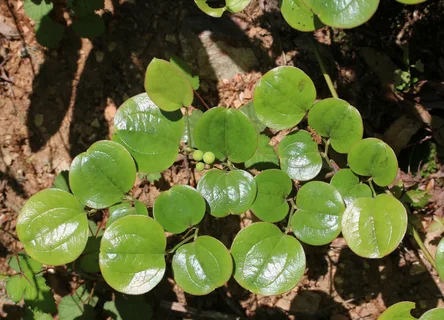
How to Identify Smilax Rotundifolia in the Wild
Identifying Smilax rotundifolia, or round-leaf greenbrier, in the wild is not too difficult if you know what to look for. One of the first things to notice is its round, glossy leaves. These leaves are typically dark green, shiny, and have a smooth surface. They are often heart-shaped or round, with a thick, leathery texture that makes them stand out from other plants around them. The leaves grow on thick, thorny vines, which helps to easily spot the plant as it climbs trees or spreads across the ground.
Another key feature of Smilax rotundifolia is its climbing vines. These vines are usually long, flexible, and covered with sharp thorns. The thorns help the plant cling to nearby trees, shrubs, or other plants as it grows upward, seeking sunlight. The vines can sometimes be a bit tricky to spot since they blend in with the surrounding vegetation, but the thorns and the climbing nature of the plant are good indicators that you are looking at Smilax rotundifolia.
In the spring and summer, the plant produces small, greenish flowers. While these flowers aren’t very large or colorful, they are important for identification. They are often hidden among the leaves, so you may need to look carefully to find them. After blooming, the flowers turn into small berries that are dark purple or black when fully ripe. The berries are round and small, which makes them another clue for identifying Smilax rotundifolia, especially if you see birds feeding on them.
The plant’s growth habit also provides clues for identification. Smilax rotundifolia prefers growing in wooded areas, often climbing on trees or spreading across the ground. You can find it in both shaded areas and spots with some sunlight. It also grows in various habitats, such as forests, wetlands, and along roadsides. If you come across a plant with these characteristics in one of these environments, it is likely Smilax rotundifolia.
To summarize, Smilax rotundifolia can be identified by its round, shiny leaves, thorny climbing vines, and small, dark berries. The plant grows in a variety of habitats and often climbs trees or spreads across the ground. By paying attention to these key features, you can spot Smilax rotundifolia in the wild and appreciate its unique appearance and role in nature.
The Health Benefits of Smilax Rotundifolia
Smilax rotundifolia, or round-leaf greenbrier, is not just a plant with a rich history of medicinal use; it also offers several health benefits that make it valuable in natural healing. One of the most well-known benefits of this plant is its ability to reduce inflammation. Smilax rotundifolia has anti-inflammatory properties that help ease pain and swelling, especially in conditions like arthritis. By soothing inflammation in the joints, it can provide relief to those who experience discomfort due to swelling or stiffness.
In addition to reducing inflammation, Smilax rotundifolia is also believed to support joint health. The plant’s natural compounds are thought to help improve mobility and flexibility, making it beneficial for people suffering from joint pain or muscle strain. Some people use the plant in teas or extracts to help with the pain and stiffness that can come with aging or physical activity. Over time, Smilax rotundifolia may help promote better joint function and reduce the risk of chronic pain.
Another key health benefit of Smilax rotundifolia is its positive effects on the respiratory system. The plant is often used in traditional medicine to treat coughs, colds, and other respiratory conditions. The soothing properties of Smilax rotundifolia help clear mucus from the airways and reduce irritation in the throat, making it easier to breathe. For people suffering from respiratory issues, this plant can offer relief and improve lung function, especially when used in herbal preparations like teas or syrups.
Smilax rotundifolia also has detoxifying effects on the body. It is commonly used to help cleanse the liver and promote better digestion. By removing toxins from the body, this plant can improve overall health and well-being. Smilax rotundifolia is believed to support the liver in processing waste products, while also improving the digestive system’s ability to absorb nutrients. People use it to promote healthier digestion and detoxify the body, especially after illnesses or during seasonal changes.
Overall, Smilax rotundifolia offers a wide range of health benefits. From reducing inflammation and supporting joint health to improving respiratory function and detoxifying the body, this plant has earned its place in traditional medicine. Whether used for pain relief, respiratory issues, or digestive health, Smilax rotundifolia continues to provide natural remedies that support a healthy lifestyle.
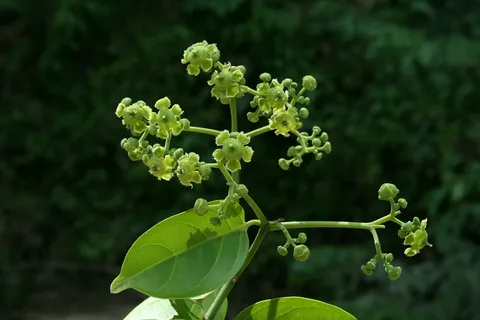
Smilax Rotundifolia: A Plant with a Long History in Folk Medicine
Smilax rotundifolia, also known as round-leaf greenbrier, has a long and rich history in folk medicine. Indigenous people in North America were among the first to recognize the plant’s healing properties. They used it for a variety of ailments, including joint pain, skin issues, and digestive troubles. The roots of the plant were often harvested and used in teas or poultices to treat conditions such as arthritis and inflammation. Over time, the knowledge of Smilax rotundifolia’s medicinal uses spread to other cultures, where it became a key part of traditional herbal medicine.
The plant’s use in folk medicine was not limited to just physical ailments; it was also believed to have spiritual significance. In some cultures, Smilax rotundifolia was used as a remedy for stress and anxiety. Its calming properties were valued, and it was thought to help balance both the body and mind. People would often drink herbal teas made from the roots or leaves to promote relaxation and improve overall well-being. This holistic approach to health, combining both physical and emotional healing, was a hallmark of the plant’s use in folk medicine.
One of the most common ways Smilax rotundifolia was used in folk medicine was for its ability to treat skin conditions. The anti-inflammatory properties of the plant made it effective for reducing swelling and irritation in the skin. It was often applied topically as a poultice or included in salves and creams to treat conditions such as eczema, rashes, or minor wounds. The plant’s soothing nature made it an excellent choice for calming inflamed skin and promoting healing.
As time passed, Smilax rotundifolia became more widely recognized for its ability to treat internal health problems. Its use for digestive issues, such as bloating, indigestion, and constipation, was well-documented in traditional herbal practices. The plant’s ability to detoxify the body and improve liver function made it a popular remedy for cleansing and promoting digestive health. Its role in supporting a healthy gut and helping to eliminate toxins from the body made it an essential part of folk medicine.
Today, Smilax rotundifolia continues to be used in various forms of alternative and herbal medicine. Its history in folk medicine is a testament to its long-standing healing properties, and modern practitioners continue to explore its potential benefits. Whether used for joint pain, skin irritation, digestive issues, or stress relief, Smilax rotundifolia remains a valuable plant in the world of natural remedies.
Growing Smilax Rotundifolia in Your Garden: A Beginner’s Guide
Smilax rotundifolia, or round-leaf greenbrier, can be a wonderful addition to any garden. This hardy plant is relatively easy to grow, especially if you provide it with the right conditions. First and foremost, Smilax rotundifolia thrives in areas with partial shade. It prefers environments where it can get a bit of sunlight but is protected from the harsh midday rays. Planting it near taller plants or trees can offer the perfect amount of shade while still allowing the plant to receive some light.
When it comes to soil, Smilax rotundifolia is not particularly picky, but it does best in well-drained, slightly acidic soil. If your garden soil is heavy or clay-like, consider adding organic matter or compost to improve drainage and fertility. This will help the plant’s roots grow strong and healthy. Smilax rotundifolia also enjoys moist soil, so it’s important to keep the ground evenly moist, especially during dry periods. However, make sure not to let the soil become waterlogged, as this can lead to root rot.
Once planted, Smilax rotundifolia will begin to spread and grow quickly, as it is a climbing vine. For this reason, it’s important to provide support for the plant to climb. You can use trellises, fences, or nearby trees to help the vine grow upward. As the plant matures, its thorny vines will wind around any available support, creating a lush, green cover. If you don’t have vertical structures available, you can also allow Smilax rotundifolia to spread across the ground, where it can form a dense mat of foliage.
One thing to keep in mind when growing Smilax rotundifolia is that it can sometimes be a bit aggressive in its growth. This plant has a tendency to spread quickly, so it’s a good idea to regularly check on it and trim back any overgrowth. Pruning will help keep the plant under control and ensure it doesn’t outgrow its space in your garden. However, its ability to cover ground and climb makes it a great choice for creating natural barriers or adding greenery to areas that need a little extra coverage.
Overall, growing Smilax rotundifolia in your garden can be a rewarding experience. It’s an easy-to-care-for plant that adds a unique touch with its glossy leaves and climbing vines. By providing the right growing conditions, such as partial shade, well-drained soil, and support for climbing, you can enjoy the beauty and benefits of Smilax rotundifolia for years to come.
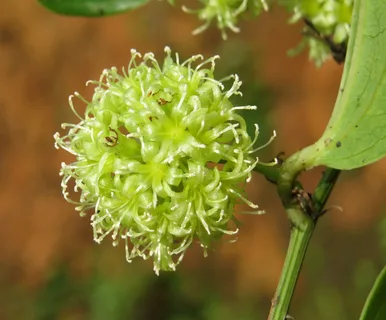
Smilax Rotundifolia vs. Other Types of Greenbrier: What’s the Difference?
Smilax rotundifolia, or round-leaf greenbrier, is just one of many species of greenbrier, but it has some unique features that set it apart from its relatives. One of the most noticeable differences is the shape of its leaves. Smilax rotundifolia has round or heart-shaped leaves, which are glossy and thick. Other types of greenbrier, such as Smilax bona-nox (common greenbrier) or Smilax hispida (bristly greenbrier), tend to have narrower, elongated leaves that are often less shiny. The round, leathery leaves of Smilax rotundifolia are a key identifying feature when compared to other species in the greenbrier family.
Another important difference lies in the plant’s growth habits. While most greenbrier species are climbing vines, the way they grow can vary. Smilax rotundifolia has relatively smooth, flexible vines covered with thorns, which allows it to climb or spread easily. In contrast, species like Smilax bona-nox have more aggressive, thorny vines that are stronger and sometimes harder to manage in a garden setting. While Smilax rotundifolia is known for its climbing ability, other greenbrier species may not climb as readily or may need more support to grow upward.
The berries of Smilax rotundifolia also set it apart from other greenbrier species. After blooming, the flowers turn into small, dark purple or black berries, which are a distinguishing feature of this plant. On the other hand, some greenbrier species like Smilax glauca (glaucous greenbrier) produce berries that are more of a blue or greenish color when ripe. While both types of berries are small and round, the color difference can help gardeners and plant enthusiasts identify one species from another.
When it comes to medicinal uses, Smilax rotundifolia is often considered milder than other greenbriers. While many greenbriers, including Smilax bona-nox, are used in traditional medicine for treating various ailments, Smilax rotundifolia is particularly known for its gentle properties in promoting joint health and reducing inflammation. Other greenbrier species, such as Smilax hispida, are sometimes used for more intense treatments, like promoting circulation or detoxifying the body, and they may come with stronger effects.
Despite these differences, all greenbrier species share certain characteristics, such as being thorny vines and having edible roots that are sometimes used in herbal remedies. However, Smilax rotundifolia’s unique leaf shape, climbing ability, and specific medicinal uses make it stand out among its greenbrier relatives. Whether you’re identifying plants in the wild or choosing one for your garden, understanding these distinctions will help you appreciate the special qualities of Smilax rotundifolia.
How to Harvest Smilax Rotundifolia Safely
Harvesting Smilax rotundifolia, or round-leaf greenbrier, requires careful attention to ensure the plant remains healthy and that you avoid injury from its thorns. The first step is to wait for the right time of year. The best time to harvest the roots or leaves of Smilax rotundifolia is in the early spring or fall when the plant’s energy is concentrated in the roots. If you plan to harvest the roots, it’s important to ensure that the plant is well-established and that you don’t over-harvest, as this can weaken the plant.
Before you start harvesting, make sure you have the right tools. A small, sharp garden spade or digging fork is ideal for carefully loosening the soil around the roots. It’s also a good idea to wear gloves to protect your hands from the plant’s sharp thorns. The vines of Smilax rotundifolia can be quite thorny, so gloves will also protect your hands from getting scratched while handling the plant. Wear long sleeves and pants to cover your arms and legs as an added precaution against the thorns.
When harvesting the roots, gently dig around the base of the plant. You want to remove only a portion of the root system, leaving enough behind for the plant to continue growing and regenerating. Be sure to dig carefully to avoid damaging the roots that remain. After harvesting, it’s important to replant the remaining root pieces so that the plant can continue to thrive. This helps ensure that Smilax rotundifolia can continue growing and producing leaves and berries for future use.
If you are harvesting the leaves, you can simply use pruning shears or scissors to cut them from the plant. Be sure to take only a few leaves at a time, leaving enough behind to keep the plant healthy and vigorous. Harvesting the leaves is much less damaging to the plant than digging up the roots, and the plant can recover more quickly. The leaves can be used fresh or dried for later use in herbal teas or remedies.
Finally, always be mindful of your local environment and regulations regarding plant harvesting. Smilax rotundifolia can be found in various parts of North America, but it’s important to make sure that you’re harvesting it sustainably. Over-harvesting can harm local populations of the plant, so always take care to leave plenty of Smilax rotundifolia behind for future generations and for wildlife that may rely on it.

The Role of Smilax Rotundifolia in Traditional Medicine
Smilax rotundifolia, commonly known as round-leaf greenbrier, has a long history of use in traditional medicine. Indigenous peoples in North America have used various parts of this plant for its medicinal properties for centuries. The roots of Smilax rotundifolia are especially valued for their ability to support joint health and reduce inflammation. In traditional medicine, the roots were often used to create teas, tinctures, or poultices to treat a variety of ailments, including arthritis, sore muscles, and joint stiffness.
One of the primary uses of Smilax rotundifolia in traditional medicine is for its anti-inflammatory effects. The root of the plant contains compounds that are believed to reduce swelling and promote healing. This made Smilax rotundifolia a popular remedy for individuals suffering from joint pain, particularly conditions like osteoarthritis. Traditional healers would recommend a tea made from the roots to help soothe the pain associated with these conditions, as well as to improve overall mobility and flexibility in the joints.
In addition to its anti-inflammatory properties, Smilax rotundifolia was also used to treat digestive issues. The plant’s roots were believed to have a mild diuretic effect, helping to flush toxins from the body and promote healthy digestion. Some practitioners used Smilax rotundifolia to treat indigestion, bloating, and other stomach discomforts. By stimulating digestion and promoting regular bowel movements, this plant played an important role in detoxifying the body and improving overall gut health.
Furthermore, Smilax rotundifolia has also been used in traditional medicine for its adaptogenic properties. It was believed to help the body cope with stress and balance various physiological functions. Some herbalists recommended it as a tonic to improve energy levels, boost the immune system, and enhance general well-being. Although modern science has not fully explored these claims, many people continue to use Smilax rotundifolia for its purported ability to support the body in times of physical or mental stress.
Despite its long history in traditional medicine, it’s important to note that Smilax rotundifolia should be used with care. As with any medicinal plant, it is best to consult with a healthcare professional before using it, especially if you are pregnant, nursing, or taking other medications. While it has been used safely by many, understanding the proper dosage and potential interactions is key to benefiting from its natural healing properties.
Fun Facts About Smilax Rotundifolia: What You Might Not Know
Smilax rotundifolia, or round-leaf greenbrier, is a fascinating plant with many interesting features. Did you know that this plant is sometimes called “the thorny vine”? While it might seem intimidating due to its sharp thorns, it plays a crucial role in the ecosystem. Smilax rotundifolia provides shelter and food for many animals. Birds, for example, enjoy its small berries, while small mammals use its tangled vines for cover. So, while the thorns may deter humans, they help make this plant a valuable part of the natural world.
Another fun fact is that Smilax rotundifolia is an incredibly resilient plant. It can thrive in a variety of environments, from the dense forests of the eastern United States to the sunny, open fields. It is often found in places with poor soil conditions, yet it still manages to grow and spread. The plant’s ability to survive and adapt to different environments is one of the reasons it has been able to survive for so long. It shows just how strong and determined nature can be, even in challenging conditions.
You might also be surprised to learn that Smilax rotundifolia has been used as a symbol in various cultures. For example, in some Native American tribes, the plant’s tough vines were seen as a symbol of strength and resilience. The round leaves of the plant were believed to represent harmony and balance, qualities that were highly valued in the culture. This symbolic meaning shows just how much respect people have had for Smilax rotundifolia throughout history.
Interestingly, Smilax rotundifolia is a plant that has both medicinal and culinary uses. While the roots are most commonly used for medicinal purposes, the young shoots of the plant can also be eaten. In some areas, the tender shoots are harvested in the spring and cooked like asparagus, offering a tasty, nutritious treat. The versatility of Smilax rotundifolia in both medicine and food is a unique trait that many people might not realize.
Finally, Smilax rotundifolia is a plant with a rich history in folklore. Some stories claim that the plant has magical properties and can be used to protect against evil spirits. In other cultures, it is believed that carrying a part of the plant can bring good luck. These fun myths and legends add to the charm of Smilax rotundifolia, making it more than just a plant, but a symbol of culture, nature, and history.
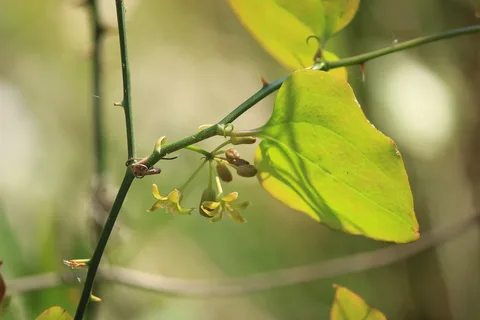
Conclusion
In conclusion, Smilax rotundifolia is a unique plant that offers many benefits. From its round, shiny leaves to its medicinal uses, this plant has a lot to offer. Whether you’re interested in its natural beauty or its history in traditional medicine, Smilax rotundifolia is definitely worth learning about. It’s a hardy plant that can grow in many different environments, making it a great addition to gardens and wild areas alike.
If you ever come across Smilax rotundifolia in the wild, take a moment to appreciate its beauty and usefulness. Remember, it’s not just a plant with pretty leaves; it’s also a valuable part of nature with a long history of helping people. So, next time you’re out exploring, keep an eye out for this fascinating plant and all the wonders it holds!
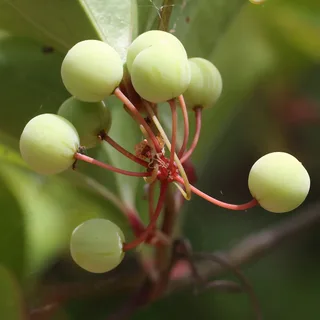













Post Comment